The weekend of Friday the 13th marked the 3rd annual Mind Meld gathering at Duncan Laurie's Jamestown, Rhode Island studio. An incredible assortment of audio and video artists were assembled, ostensibly to relax, but with so much talent in one place, a show or two is inevitable.
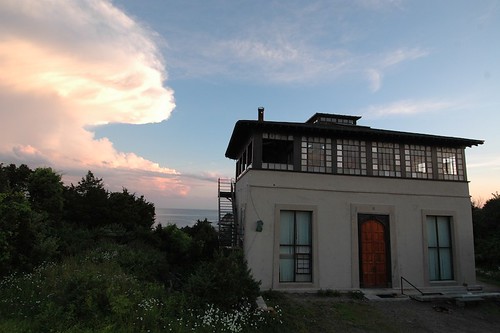
Dragonline Studio.
Duncan's three-storey studio sits atop Bull Point, surrounded by water on three sides. The studio was built entirely out of salvaged materials. Floors made of glass block allow light to penetrate up from the lower workshop, through the main room and into the laboratory on the top floor. It is on the top floor that Duncan and his electrical engineer Gordon Salisbury have been experimenting with sonifying signals from Nature. There is an impressive array of old Radionic equipment as well as a number of devices that Gordon has developed. The visual centerpiece of the lab is the "Music Machine", an 8' tall cuboctahedron that was part of a GENESIS Bio-Entrainment Module, a bio-feedback device developed in the 1980's. The machine is now host to Gordon's Purr Generator. The purr generator is a device which generates a signal at approximately 25 Hz. This coincides with the frequency of vibrations given off by a “happy cat” and has long been thought to be therapeutic. External audio sources can be played through the machine.
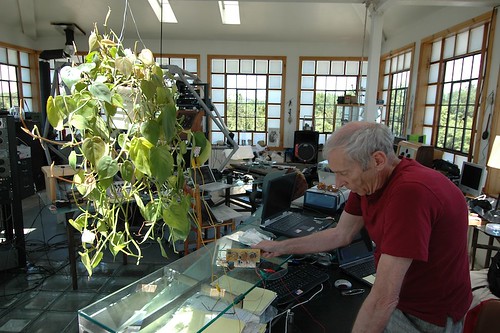
Gordon dialing in a plant.
Much of the activity at the studio in the last few years has been given over to exploring signals in Nature. Based on precedents set by Cleve Backster and T. Townsend Brown, plants and rocks are fitted with electrodes or have copper leads affixed to them. Small voltages present are picked up with a variety of test equipment, including Wheatstone bridges, rate of change convertors, EKGs, and the IBVA brainwave monitor. The resulting data streams are converted to MIDI and used to drive Ableton Live.
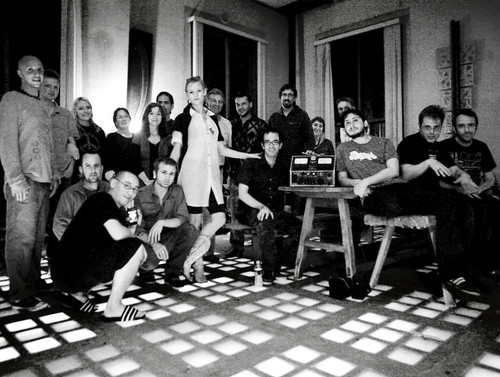
( Photo by Arrow )
For the artists that have assembled each year, the draw of a fantastic location, strange nature research and wealth of information about Radionics that Duncan possesses are too much to resist. This years gathering included mainstays; Steve Nalepa, a West Coast electronic musician, gaining attention with his forthcoming Flatlands CD/DVD and Bass Science, a dubstep project with MattB; Todd Thille ( aka Synesthete ), an Istanbul based VJ and multimedia artist currently engaged in designing new software and hardware for the explorations underway at Duncan's studio; David Lublin, of Vidvox, makers of the popular VJ software VDMX; Josh Randall ( aka Robotkid ), a Creative Director at Harmonix by day, working titles like Rock Band and Phase; Aerostatic, the Brooklyn based couple Michelle Darling and Terry Golob, who's style ranges from ambient to breakcore with some Seseame Street (both have worked at Sesame Workshop) in for good measure.
Newer faces included Brian Kane, a former member of EBN and the self described "Karl Rove of the art world, who was busy pushing his latest meme, Meat Water; Ooah, one of the members of rising stars, the Glitch Mob; Richard Devine, still recovering from a near death experience after a small wound on his foot, infected with staph, nearly destroyed his heart, came to reek sonic mayhem with a massive stack of modular synths; Josh Kay ( aka Jeswa ), who joined Richard in exploring the sonic possibilities of the studio, and a formidable force in his right as a member of Soul Oddity and Phoenecia and founder of Schematic Records; CDM's own Peter Kirn rounded out the list of performing artists.
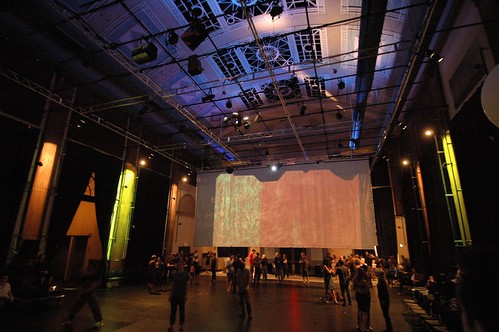
we'll do it live - Pell Chaffey Hall
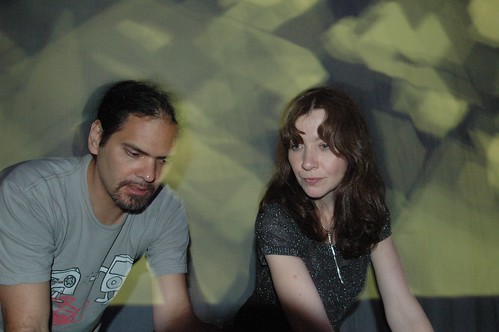
we'll do it live - Aerostatic (Terry & Michelle)
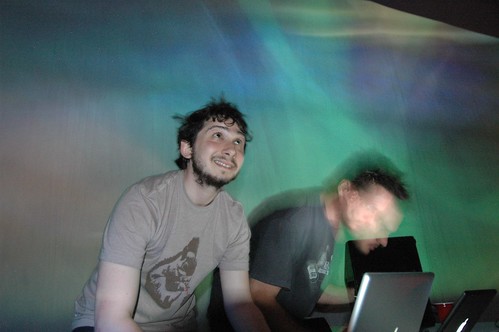
we'll do it live - David Lublin & Nalepa
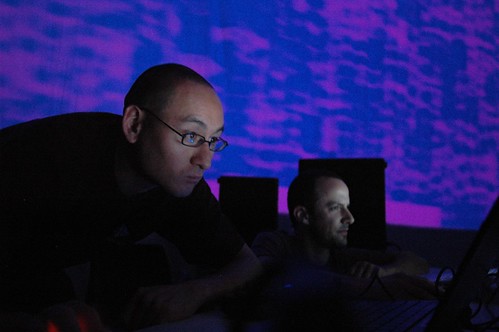
we'll do it live - Richard Devine & Josh Kay
Through the work of Elizabeth Keithline and Nick Bauta of The Steel Yard and Firehouse 13, the audio visual extravaganza, "we'll do it live" found a home at the Pell-Chafee center in downtown Providence. Two massive 40' wide screens were hung from the three-story vaulted ceiling. Duncan and Aerostatic opened with an exploration of signals coming from a piece of granite (seen in their Rockstar short) and a banana. Peter Kirn deftly handled Kore for his 30 minute set with reactive visuals by Synestete. Brian Kane performed selections from his triple-head av masterpiece, HDADD. Robotkid and rndm threw down a bumpin' av mashup. Nalepa and David Lublin got the party moving with Flatlands remixes, dubstep tracks and ethereal hand-held footage with Quartz Composer overlays. Ooah brought out the glitch hop with his Panty Raid and tracks from other Mob members. Richard Devine and Josh Kay double-teamed Traktor, bring the soundsystem down with meters in the red and finishing out the night with TapStereo.
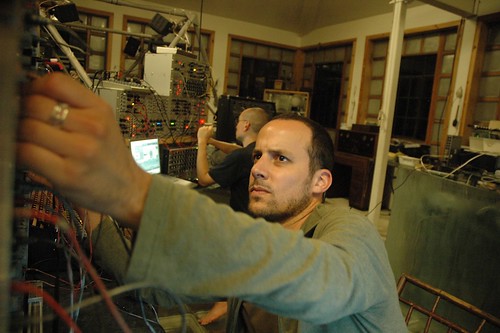
Josh Kay and Richard Devine.
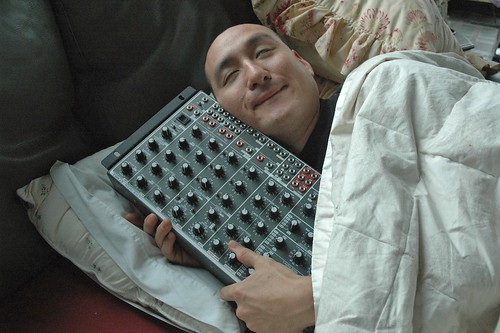
Richard Devine dreaming of Swedish engineering.
The event picked up and relocated to Duncan's studio where Richard and Josh Kay set up a wall of modular synths to plug into the different sound sources. Peter got busy writing an FFT patch in Processing and tried it out with signals coming from an onion and a lime. He also experimented with Gordon's Bat Box. The rest of the crew amused themselves with Rock Band and chatting in small groups around the bar-b-gue that sprang up on the driveway.
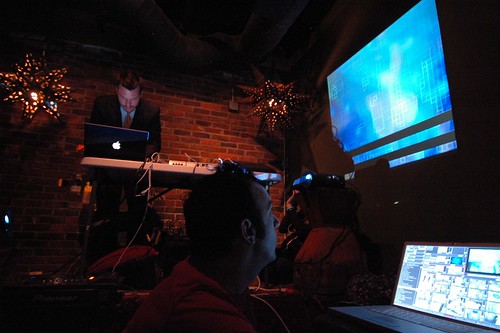
Beat Research - Nalepa and Robotkid.
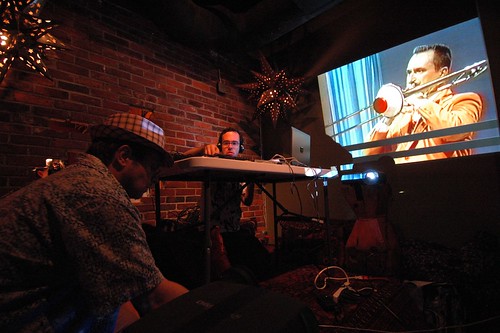
Beat Research - Brian Kane and Peter Kirn.
The group started to disperse on Sunday and everyone but Richard and Josh Kay had left by the time that Steve, his girl Arrow, Peter and I headed up to Boston on Monday night. We met up with Robotkid and Brian Kane for a show in Cambridge at Beat Research. There was a good crowd despite it being a rainy school night. Peter had much better control over his Kore set. Robotkid and I mixed visuals until Brian fired up his DVJ and played some of his AV pieces. Nalepa came in a pinstripe suit and tore up the room with Bass Science dubstep.
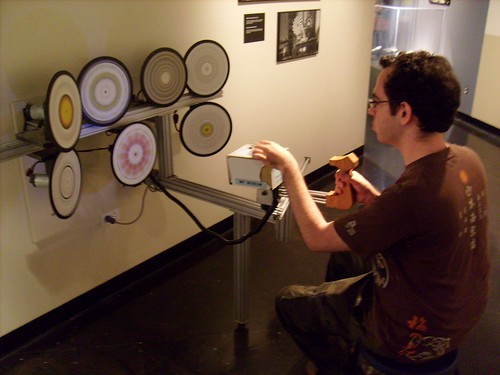
Peter working the strobes at the MIT Museum.
Peter and I started Tuesday morning at the new offices of Harmonix. We decided not to get sucked into any meetings and beat a retreat to the MIT Museum. There were good exhibits on deep sea craft, high-speed photography and sculptor Arthur Ganson.

Nalepa with visionary artist Paul Laffoley.
The afternoon brought a visit to the studio of visionary painter Paul Laffoley. He had requested a chicken stuffed in a watermelon, potential racial slur aside, we obliged and hand delivered him a "chelon." Paul was in the midst of prepping for a 60s and 70s retrospective that is to be on display in New York in February. He was also hard at work on a Tarot deck. We parted with Peter afterwards and the 3rd annual Mind Meld came to a close.
















